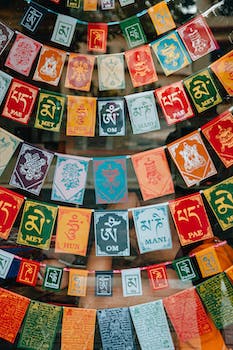

-
Table of Contents
Unleash your inner divinity with Om Mani Padme Hum.
Introduction
"Discovering the Divine Within: Unveiling the Jewel of Om Mani Padme Hum" is a spiritual journey that explores the profound meaning and transformative power of the ancient mantra, Om Mani Padme Hum. This mantra, deeply rooted in Tibetan Buddhism, holds immense significance and is believed to contain the essence of all Buddhist teachings. Through this book, readers are invited to delve into the depths of their own being, uncovering the divine wisdom and compassion that resides within each individual. By unraveling the layers of this sacred mantra, the book aims to guide readers towards self-discovery, inner peace, and a deeper connection with the divine.
The Power of Self-Discovery: Unveiling the Divine Within through Om Mani Padme Hum
Discovering the Divine Within: Unveiling the Jewel of Om Mani Padme Hum
In the quest for self-discovery and spiritual enlightenment, many individuals turn to ancient practices and teachings that have stood the test of time. One such practice is the recitation of the mantra "Om Mani Padme Hum." This powerful mantra, rooted in the Buddhist tradition, holds within it the key to unlocking the divine within ourselves.
Om Mani Padme Hum is a six-syllable mantra that is believed to contain the essence of all the teachings of Buddhism. Each syllable represents a different aspect of enlightenment, and when chanted or recited, it is said to have the power to purify the mind and bring about a deep sense of inner peace and harmony.
The first syllable, "Om," is considered the most sacred sound in the universe. It represents the primordial sound from which all creation arises. Chanting this syllable helps to align our consciousness with the universal energy and opens the door to higher states of awareness.
The second syllable, "Mani," means jewel in Sanskrit. It symbolizes the jewel of compassion, which is said to reside within each and every one of us. By reciting this syllable, we are reminded of our inherent capacity for love and kindness, and we are encouraged to cultivate these qualities in our daily lives.
The third syllable, "Padme," means lotus in Sanskrit. The lotus is a powerful symbol in Buddhism, representing purity and spiritual awakening. Chanting this syllable helps to purify our thoughts and emotions, allowing us to let go of negativity and embrace a state of inner clarity and peace.
The fourth syllable, "Hum," represents the indivisible union of wisdom and compassion. It is a call to action, reminding us that true enlightenment is not just about personal growth and self-realization, but also about using our newfound wisdom and compassion to benefit others. By reciting this syllable, we are reminded of our interconnectedness with all beings and are inspired to live a life of service and compassion.
The power of Om Mani Padme Hum lies not only in its individual syllables but also in the collective energy created when it is recited by a group of people. When we come together in a shared intention and chant this mantra, we amplify its transformative power and create a powerful field of positive energy that can bring about profound healing and transformation.
To incorporate the practice of Om Mani Padme Hum into your daily life, you can start by setting aside a few minutes each day for quiet reflection and chanting. Find a comfortable and peaceful space where you can sit undisturbed, close your eyes, and take a few deep breaths to center yourself.
As you begin to chant the mantra, allow the sound to resonate within you, feeling its vibrations reverberate throughout your body and mind. Focus your attention on the meaning and symbolism of each syllable, allowing their wisdom and power to penetrate your being.
With regular practice, you will begin to experience the transformative effects of Om Mani Padme Hum in your life. You may find that your mind becomes more calm and focused, your heart more open and compassionate, and your overall sense of well-being deepens.
In conclusion, the mantra Om Mani Padme Hum holds within it the key to unlocking the divine within ourselves. Through its sacred syllables, we are reminded of our inherent capacity for love, compassion, and wisdom. By incorporating this powerful mantra into our daily lives, we can embark on a journey of self-discovery and spiritual awakening, unveiling the jewel of our true nature.
Exploring the Spiritual Significance of Om Mani Padme Hum: A Path to Discovering the Divine Within

Om Mani Padme Hum is a powerful mantra that holds deep spiritual significance in various Eastern traditions. It is a sacred chant that is believed to contain the essence of the entire Buddhist teachings. Translated as "Hail to the Jewel in the Lotus," this mantra is a path to discovering the divine within ourselves.
The mantra is composed of six syllables, each representing a different aspect of enlightenment. "Om" is the first syllable and is considered the most sacred sound in Hinduism and Buddhism. It represents the universal consciousness and the divine energy that permeates all existence. Chanting "Om" helps to align our own consciousness with the divine.
The second syllable, "Mani," means jewel. It symbolizes the preciousness and purity of our own inner being. It reminds us that we are all divine beings, capable of radiating love and compassion. By chanting "Mani," we acknowledge and honor the divine jewel within ourselves.
The third syllable, "Padme," means lotus. The lotus is a powerful symbol in Eastern spirituality, representing purity and spiritual growth. Just as a lotus grows from the muddy waters, we too can rise above our own limitations and transform ourselves into beings of light and love. Chanting "Padme" helps us connect with our own inner lotus, nurturing its growth and allowing it to blossom.
The fourth syllable, "Hum," represents the indivisible unity of all things. It signifies the interconnectedness of all beings and the realization that we are all part of a greater whole. Chanting "Hum" helps us dissolve the illusion of separation and recognize the divine presence in everything and everyone around us.
By chanting the mantra "Om Mani Padme Hum," we embark on a journey of self-discovery and spiritual awakening. It is a path that leads us to the realization that the divine resides within us, waiting to be unveiled. Through the repetition of these sacred syllables, we align ourselves with the divine energy and open ourselves to its transformative power.
Chanting the mantra can be a deeply meditative practice. As we focus on each syllable, we quiet the mind and enter a state of deep inner stillness. In this state, we become more receptive to the divine guidance and wisdom that resides within us. The mantra acts as a bridge between our ordinary consciousness and the higher realms of spiritual awareness.
The power of the mantra lies not only in its sound but also in the intention behind it. When we chant with sincerity and devotion, we create a powerful vibration that resonates with the divine energy. This vibration has the potential to purify our own consciousness and bring about profound healing and transformation.
In conclusion, Om Mani Padme Hum is a sacred mantra that holds the key to discovering the divine within ourselves. Through its six syllables, we connect with the universal consciousness, honor the divine jewel within us, nurture our inner lotus, and realize the interconnectedness of all things. By chanting this mantra with sincerity and devotion, we embark on a transformative journey of self-discovery and spiritual awakening.
Unveiling the Jewel Within: How Om Mani Padme Hum Can Awaken the Divine Essence
Discovering the Divine Within: Unveiling the Jewel of Om Mani Padme Hum
Om Mani Padme Hum, a sacred mantra in Tibetan Buddhism, holds within it the power to awaken the divine essence that resides within each of us. This ancient mantra, often translated as "Hail to the Jewel in the Lotus," is a profound invocation that can lead us on a transformative journey towards self-realization and spiritual enlightenment.
At its core, Om Mani Padme Hum is a mantra of compassion and wisdom. It is believed to be the embodiment of the enlightened mind of Avalokiteshvara, the bodhisattva of compassion. By reciting this mantra, we align ourselves with the compassionate and wise qualities of Avalokiteshvara, and open ourselves to the divine energy that flows through all beings.
The first syllable, "Om," represents the universal sound of creation. It is the primordial vibration that gives birth to all existence. When we chant "Om," we connect with the cosmic energy that permeates the entire universe. This sacred syllable serves as a reminder of our interconnectedness with all living beings and the divine source from which we originate.
The second syllable, "Mani," means jewel. It symbolizes the preciousness and purity of our true nature. Just as a jewel is hidden within a rough exterior, our divine essence is often obscured by the layers of conditioning and ego. By chanting "Mani," we acknowledge the inherent beauty and brilliance that lies within us, waiting to be discovered.
The third syllable, "Padme," translates to lotus. The lotus is a powerful symbol in Buddhism, representing spiritual awakening and enlightenment. Like a lotus that emerges from the muddy waters, we too can rise above the challenges and difficulties of life to blossom into our highest potential. Chanting "Padme" reminds us of our capacity for growth and transformation, and encourages us to embrace the path of spiritual evolution.
The fourth syllable, "Hum," signifies indivisibility. It represents the unity of all things and the dissolution of dualistic perception. When we chant "Hum," we dissolve the illusion of separation and recognize the inherent oneness of all existence. This syllable serves as a reminder that we are not separate from the divine, but rather an integral part of it.
By chanting Om Mani Padme Hum, we embark on a journey of self-discovery and self-transcendence. This sacred mantra has the power to purify our mind, body, and spirit, and awaken the dormant divine qualities within us. It is a powerful tool for cultivating compassion, wisdom, and spiritual growth.
As we chant this mantra, we become attuned to the divine vibrations that permeate the universe. We align ourselves with the compassionate and wise energy of Avalokiteshvara, and open ourselves to the transformative power of divine love. Through the repetition of Om Mani Padme Hum, we purify our thoughts, emotions, and actions, and cultivate a deep sense of inner peace and harmony.
In conclusion, Om Mani Padme Hum is a jewel of wisdom and compassion that can guide us on a profound spiritual journey. By chanting this sacred mantra, we awaken the divine essence within us and align ourselves with the universal energy of love and compassion. Let us embrace the power of Om Mani Padme Hum and discover the divine jewel that resides within each of us.
Q&A
1. What is "Discovering the Divine Within: Unveiling the Jewel of Om Mani Padme Hum" about?
"Discovering the Divine Within: Unveiling the Jewel of Om Mani Padme Hum" is a book that explores the spiritual concept of Om Mani Padme Hum and guides readers on a journey to discover their inner divinity.
2. Who is the author of "Discovering the Divine Within: Unveiling the Jewel of Om Mani Padme Hum"?
The author of "Discovering the Divine Within: Unveiling the Jewel of Om Mani Padme Hum" is Lama Surya Das.
3. What is the significance of Om Mani Padme Hum?
Om Mani Padme Hum is a mantra commonly associated with Tibetan Buddhism. It is believed to contain the essence of all Buddhist teachings and is chanted to invoke compassion and wisdom.
Conclusion
In conclusion, "Discovering the Divine Within: Unveiling the Jewel of Om Mani Padme Hum" is a book that explores the spiritual significance and transformative power of the mantra Om Mani Padme Hum. It delves into the depths of self-discovery and guides readers towards uncovering their inner divinity through the practice of this sacred mantra.












